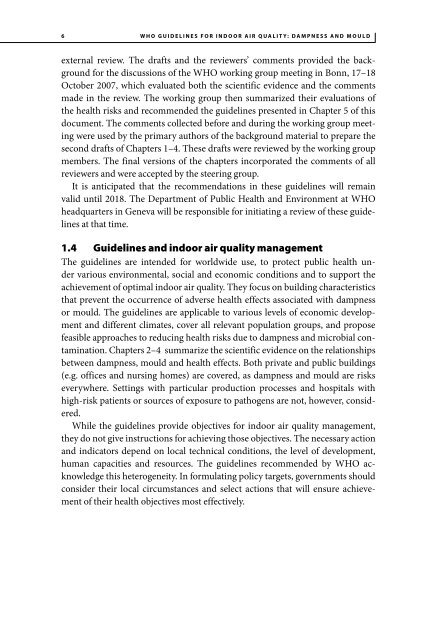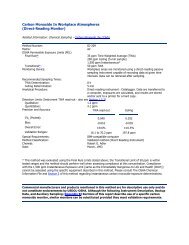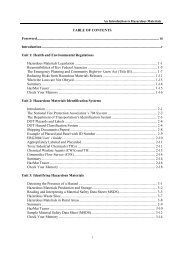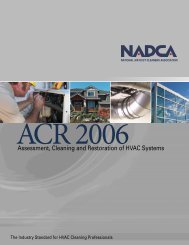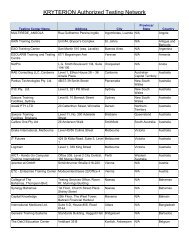Dampness and Mould - WHO guidelines for indoor air quality - PRWeb
Dampness and Mould - WHO guidelines for indoor air quality - PRWeb
Dampness and Mould - WHO guidelines for indoor air quality - PRWeb
You also want an ePaper? Increase the reach of your titles
YUMPU automatically turns print PDFs into web optimized ePapers that Google loves.
6 <strong>WHO</strong> GUIDELINES FOR INDOOR AIR QUALITY: DAMPNESS AND MOULD<br />
external review. The drafts <strong>and</strong> the reviewers’ comments provided the background<br />
<strong>for</strong> the discussions of the <strong>WHO</strong> working group meeting in Bonn, 17–18<br />
October 2007, which evaluated both the scientific evidence <strong>and</strong> the comments<br />
made in the review. The working group then summarized their evaluations of<br />
the health risks <strong>and</strong> recommended the <strong>guidelines</strong> presented in Chapter 5 of this<br />
document. The comments collected be<strong>for</strong>e <strong>and</strong> during the working group meeting<br />
were used by the primary authors of the background material to prepare the<br />
second drafts of Chapters 1–4. These drafts were reviewed by the working group<br />
members. The final versions of the chapters incorporated the comments of all<br />
reviewers <strong>and</strong> were accepted by the steering group.<br />
It is anticipated that the recommendations in these <strong>guidelines</strong> will remain<br />
valid until 2018. The Department of Public Health <strong>and</strong> Environment at <strong>WHO</strong><br />
headquarters in Geneva will be responsible <strong>for</strong> initiating a review of these <strong>guidelines</strong><br />
at that time.<br />
1.4 Guidelines <strong>and</strong> <strong>indoor</strong> <strong>air</strong> <strong>quality</strong> management<br />
The <strong>guidelines</strong> are intended <strong>for</strong> worldwide use, to protect public health under<br />
various environmental, social <strong>and</strong> economic conditions <strong>and</strong> to support the<br />
achievement of optimal <strong>indoor</strong> <strong>air</strong> <strong>quality</strong>. They focus on building characteristics<br />
that prevent the occurrence of adverse health effects associated with dampness<br />
or mould. The <strong>guidelines</strong> are applicable to various levels of economic development<br />
<strong>and</strong> different climates, cover all relevant population groups, <strong>and</strong> propose<br />
feasible approaches to reducing health risks due to dampness <strong>and</strong> microbial contamination.<br />
Chapters 2–4 summarize the scientific evidence on the relationships<br />
between dampness, mould <strong>and</strong> health effects. Both private <strong>and</strong> public buildings<br />
(e.g. offices <strong>and</strong> nursing homes) are covered, as dampness <strong>and</strong> mould are risks<br />
everywhere. Settings with particular production processes <strong>and</strong> hospitals with<br />
high-risk patients or sources of exposure to pathogens are not, however, considered.<br />
While the <strong>guidelines</strong> provide objectives <strong>for</strong> <strong>indoor</strong> <strong>air</strong> <strong>quality</strong> management,<br />
they do not give instructions <strong>for</strong> achieving those objectives. The necessary action<br />
<strong>and</strong> indicators depend on local technical conditions, the level of development,<br />
human capacities <strong>and</strong> resources. The <strong>guidelines</strong> recommended by <strong>WHO</strong> acknowledge<br />
this heterogeneity. In <strong>for</strong>mulating policy targets, governments should<br />
consider their local circumstances <strong>and</strong> select actions that will ensure achievement<br />
of their health objectives most effectively.


